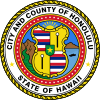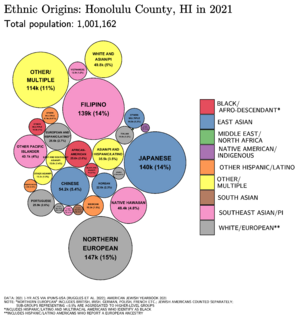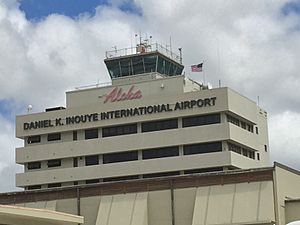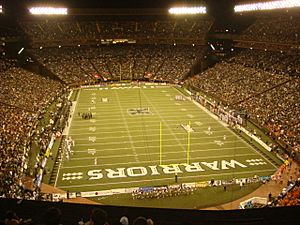Honolulu County, Hawaii facts for kids
Quick facts for kids
Honolulu County
|
|||
|---|---|---|---|
|
Consolidated city-county
|
|||
| City and County of Honolulu Kūlanakauhale a me ke Kalana o Honolulu (Hawaiian) |
|||
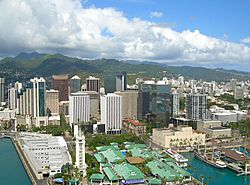
Downtown Honolulu, the city and county urban center
|
|||
|
|||
| Motto(s):
Haʻaheo No ʻO Honolulu
(The Pride of Honolulu) |
|||
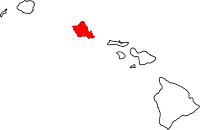
Location in the state of Hawaii (Northwestern Hawaiian Islands not shown)
|
|||
| Country | United States | ||
| State | Hawaii | ||
| Incorporated | April 30, 1907 | ||
| Seat | Honolulu | ||
| Government | |||
| • Type | Mayor–council | ||
| Area | |||
| • Total | 2,128 sq mi (5,510 km2) | ||
| • Land | 601 sq mi (1,560 km2) | ||
| • Water | 1,527 sq mi (3,950 km2) 71.8% | ||
| Population
(2020)
|
|||
| • Total | 1,016,508 | ||
| • Density | 1,691/sq mi (653/km2) | ||
| GDP | |||
| • MSA | $74.422 billion (2022) | ||
| Time zone | UTC−10 (Hawaii–Aleutian) | ||
| Area code(s) | 808 | ||
| Website | honolulu.gov | ||
Honolulu County, also known as the City and County of Honolulu, is a special type of government area in Hawaii. It combines the jobs of both a city and a county. This means it handles things that cities and counties usually do in other parts of the United States.
The county includes the main city of Honolulu, which is Hawaii's capital and largest community. It also covers the rest of the island of Oʻahu. Plus, it includes many smaller islands far away, like most of the Northwestern Hawaiian Islands.
The government for Honolulu County was set up in 1907. It manages many important services for the people living there. As of 2020, over 1 million people call Honolulu County home. This makes it a very busy and important place in Hawaii. The county's motto is "Haʻaheo No ʻO Honolulu," which means "The Pride of Honolulu."
Contents
Geography and Nature
Honolulu County is quite large. It covers about 2,128 square miles. Most of this area, about 71.8%, is water, which is the Pacific Ocean. Only about 601 square miles is land.
This county is the widest in the United States. It stretches over 1,380 miles from one end to the other!
Protected Areas
Honolulu County is home to several important natural areas. These places help protect wildlife and history:
- James Campbell National Wildlife Refuge
- Oʻahu Forest National Wildlife Refuge
- Papahānaumokuākea Marine National Monument
- Pearl Harbor National Wildlife Refuge
- USS Arizona Memorial
People of Honolulu County
The population of Honolulu County has grown a lot over the years. In 1900, there were about 58,504 people. By 2020, the population reached 1,016,508! This means about 70% of all people in Hawaii live in Honolulu County.
| Historical population | |||
|---|---|---|---|
| Census | Pop. | %± | |
| 1900 | 58,504 | — | |
| 1910 | 81,993 | 40.1% | |
| 1920 | 123,496 | 50.6% | |
| 1930 | 202,887 | 64.3% | |
| 1940 | 257,696 | 27.0% | |
| 1950 | 353,020 | 37.0% | |
| 1960 | 500,409 | 41.8% | |
| 1970 | 629,176 | 25.7% | |
| 1980 | 762,565 | 21.2% | |
| 1990 | 836,231 | 9.7% | |
| 2000 | 876,156 | 4.8% | |
| 2010 | 953,207 | 8.8% | |
| 2020 | 1,016,508 | 6.6% | |
| 2023 (est.) | 989,408 | 3.8% | |
| U.S. Decennial Census 1790-1960 1900-1990 1990-2000 2010-2018 |
|||
People from many different backgrounds live here. In 2010, about 43.9% of residents were Asian. About 20.8% were white, and 9.5% were Pacific Islander. Many people also identify with two or more races. About 9.1% of the population was Hispanic or Latino.
Some of the largest family backgrounds include:
Economy and Jobs
Honolulu County has a strong economy. Many people work for the government or in healthcare.
Major Employers
Here are some of the biggest employers in Honolulu County as of 2022:
| # | Employer | # of Employees |
|---|---|---|
| 1 | State of Hawaii | 66,900 |
| 2 | United States Government | 34,700 |
| 3 | City and County of Honolulu | 18,600 |
| 4 | The Queen's Health Systems | 8,426 |
| 5 | Hawaii Pacific Health | 7,119 |
| 6 | Kaiser Foundation Health Plan | 4,382 |
| 7 | Hawaiian Electric Industries Inc. | 3,649 |
| 8 | Kamehameha Schools | 3,357 |
| 9 | Oahu Transit Services Inc. | 2,063 |
| 10 | First Hawaiian Bank | 1,858 |
Other large companies based here include Hawaiian Airlines, Aloha Air Cargo, and Bank of Hawaii.
Transportation
Getting around Honolulu County is important. There are many ways to travel by air, road, and public transport.
Air Travel
Honolulu International Airport (HNL) is the main airport for all of Hawaii. Many airlines fly here from across the Pacific Ocean. Hawaiian Airlines, which is based in Hawaii, also flies to other islands and major cities.
Major Roads
Honolulu County has several important highways that help people get around the island of Oahu. These include:
 H-1
H-1 H-2
H-2 H-3
H-3 H-201
H-201 Route 61
Route 61 Route 63
Route 63 Route 65
Route 65 Route 72
Route 72 Route 80
Route 80 Route 83
Route 83 Route 93
Route 93 Route 95
Route 95 Route 99
Route 99 Route 750
Route 750 Route 801
Route 801 Route 803
Route 803 Route 830
Route 830 Route 930
Route 930
Public Transportation
Honolulu County has two main public transportation services: buses and a new train system. You can pay for both using a special HOLO card.
Bus System
TheBus is the public bus service. It has 106 routes that cover many areas. TheBus is one of the most used public transportation systems per person in major U.S. cities.
Rail System
Skyline is a new light rail train system. The first part of the line opened in June 2023. It connects East Kapolei to Aloha Stadium. More parts of the line are planned to open in the future, reaching the airport and downtown Honolulu.
Education
Honolulu County offers many choices for schools and colleges.
Colleges and Universities
Public colleges are part of the University of Hawaiʻi System. These include:
- University of Hawaiʻi at Mānoa (the main campus)
- Honolulu Community College
- Kapiolani Community College
- Leeward Community College
- University of Hawaiʻi – West Oʻahu
- Windward Community College
There are also private colleges like Chaminade University, Hawaii Pacific University, and Brigham Young University–Hawaii.
Schools for Kids
The Hawaii Department of Education runs public schools in Honolulu County. Many private schools are also available. Honolulu County has one of the highest rates of private school enrollment in the United States.
Some well-known private schools include:
- Kamehameha Schools–Kapālama
- Punahou School
- ʻIolani School
- Mid-Pacific Institute
- Le Jardin Academy
- Island Pacific Academy
There are also many private schools connected to religious groups.
Public Libraries
The Hawaii State Public Library System has many libraries in Honolulu County. The Hawaii State Library is the main one. There are also 22 branch libraries across the county.
Arts and Culture
Honolulu County is a lively place for arts and culture, with music, theater, and museums.
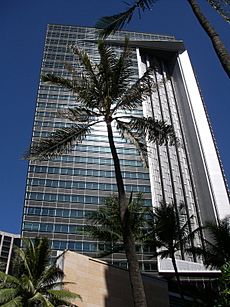
Performing Arts
The Hawaii Symphony Orchestra started in 1900. It is the oldest symphony orchestra west of the Rocky Mountains in the U.S. The Royal Hawaiian Band is even older, started in 1836 by King Kamehameha III. It's the only full-time city band in the U.S. with a royal history!
Other groups include the Hawaii Opera Theatre. Honolulu is also famous for Hawaiian music. You can see shows at places like the Neal Blaisdell Center Concert Hall, the Waikiki Shell, and the Hawaii Theatre. There are also live theater venues like Diamond Head Theatre.
Visual Arts
The Honolulu Museum of Art has a huge collection of Asian and Western art. It also has the largest collection of Islamic art, found at the Shangri La estate. The museum also shows art films at its Doris Duke Theatre.
The Capitol Modern Museum shows art by local artists and traditional Hawaiian art.
Natural Museums and Gardens
The Bishop Museum is the biggest museum in Honolulu. It has the largest collection of natural history items in Hawaii. It also has the world's largest collection of Hawaiian and Pacific culture artifacts.
The Honolulu Zoo is the main zoo in Hawaii. The Waikiki Aquarium is a working lab for studying ocean life. Honolulu also has beautiful gardens like Foster Botanical Garden and Liliuokalani Botanical Garden.
Sports and Activities
Honolulu does not have professional sports teams. However, it loves college and high school sports! The Aloha Stadium used to host the NFL's Pro Bowl game. It also hosts the Hawaii Bowl college football game every year.
Fans often cheer for the University of Hawaiʻi at Mānoa's football, volleyball, basketball, and baseball teams. High school football games are also very popular.
Places to watch sports include:
- Aloha Stadium (for American football and soccer)
- Les Murakami Stadium (for baseball)
- Stan Sheriff Center (for basketball and volleyball)
- Neal Blaisdell Center Arena (for basketball)
Because of its mild weather, Honolulu is great for outdoor activities all year. In 2004, Men's Fitness magazine called Honolulu the "fittest city" in the U.S.
Honolulu also hosts three big running events:
- The Great Aloha Run happens every Presidents' Day.
- The Honolulu Marathon is held every December. More than 20,000 people join, many from Japan.
- The Honolulu Triathlon is an Olympic-distance race held every May.
Communities
Honolulu County is made up of many different communities. The U.S. Census Bureau divides these into "census-designated places" for statistics.
Census-Designated Places
- ʻĀhuimanu
- ʻAiea
- East Honolulu
- East Kapolei
- ʻEwa Beach
- ʻEwa Gentry
- ʻEwa Villages
- Hālawa
- Haleʻiwa
- Hauʻula
- Helemano
- Heʻeia
- Hickam Housing
- Honolulu
- Iroquois Point
- Kaʻaʻawa
- Kahaluʻu
- Kahuku
- Kailua
- Kalaeloa
- Kāneʻohe
- Kaneohe Base (Marine Corps Base Hawaiʻi)
- Kapolei
- Kawela Bay
- Ko Olina
- Lāʻie
- Māʻili
- Mākaha
- Mākaha Valley
- Makakilo
- Maunawili
- Mililani Mauka
- Mililani Town
- Mokulēʻia
- Nānākuli
- Ocean Pointe
- Pearl City
- Punaluʻu
- Pūpūkea
- Royal Kunia (formerly Village Park)
- Schofield Barracks
- Wahiawā
- Waiāhole
- Waialua
- Waiʻanae
- Waikāne
- Waikele
- Waimalu
- Waimānalo
- Waimānalo Beach
- Waipahu
- Waipiʻo
- Waipiʻo Acres
- West Loch Estate
- Wheeler Army Airfield
- Whitmore Village
Other Places
Sister Cities
See also
 In Spanish: Condado de Honolulu para niños
In Spanish: Condado de Honolulu para niños



